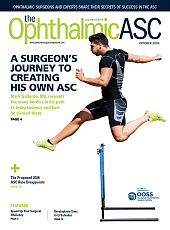Aflibercept 8 mg (Eylea HD; Regeneron) achieved noninferior vision gains with fewer injections than aflibercept 2 mg (Eylea; Regeneron) in treatment-naïve patients with macular edema secondary to retinal vein occlusion (RVO), according to 36-week data from the phase 3 QUASAR trial presented at the 2025 American Society of Retina Specialists meeting in Long Beach, California.
Seenu M. Hariprasad, MD, the Shui-Chin Lee Endowed Professor, ophthalmologist-in-chief and chair, and director of fellowship in the diseases and surgery of the retina, macula, and vitreous in the department of ophthalmology and visual science at the University of Chicago, delivered the results on behalf of the QUASAR study investigators. He noted that the study demonstrated consistent outcomes across branch retinal vein occlusion (BRVO), central retinal vein occlusion (CRVO), and hemiretinal vein occlusion (HRVO) subtypes.
“Our primary endpoint was met,” Dr. Hariprasad said. “Aflibercept 8 mg groups achieved noninferior vision gains compared to 2 mg aflibercept dosed every 4 weeks, and at week 36 this was attained with fewer injections overall, and importantly across all retinal vein occlusion subtypes.”
The QUASAR trial is evaluating 3 dosing strategies for aflibercept 8 mg, with interval adjustments allowed based on protocol-defined response criteria. After 3 initial monthly injections, patients in the 8 mg groups required an average of 6.1 injections at week 36, compared to 8.8 injections in the 2 mg group. “Most importantly, in the most difficult to treat CRVO and HRVO subtypes, vision was not compromised, with fewer injections of aflibercept 8 mg,” noted Dr. Hariprasad.
Anatomic improvements tracked closely with visual outcomes. “Both the aflibercept 8 mg groups achieved robust central retinal thickness reductions compared to 2 mg at week 36, with fewer injections overall and across all RVO subtypes,” he added. This included consistent drying effects in CRVO, HRVO, and BRVO eyes.
One of the key differences observed between treatment arms was the ability to extend treatment intervals. “At week 36, about 70% of patients had a last assigned dosing interval of every 12 weeks,” Dr. Hariprasad said. By contrast, 25% of patients in the 2 mg group still required monthly injections, he said, compared with only 6% in the 8 mg arms.
When analyzed by RVO subtype, this pattern held steady. “With 8 mg of aflibercept, approximately 70% of patients regardless of RVO subtype could get up to every-12-week dosing,” Dr. Hariprasad said. “All said and done, the number of patients who needed every-4-week dosing of aflibercept was 3 to 4 times higher in 2 mg compared to 8 mg of aflibercept.”
Safety outcomes through 36 weeks showed no new concerns. “Aflibercept 8 mg was well tolerated and consistent with the already established safety profile of aflibercept 2 mg and the already approved indications for aflibercept 8 mg,” he said. Dr. Hariprasad concluded that aflibercept 8 mg may offer retina specialists an opportunity to reduce treatment burden without compromising efficacy in patients with RVO.
The 36-week data represent the primary endpoint of the ongoing QUASAR trial, a global, double-masked, randomized, active-controlled phase 3 study. It includes more than 800 patients across 27 countries and compares aflibercept 8 mg regimens to aflibercept 2 mg dosed every 4 weeks. Treatment intervals could be adjusted based on predefined dose regimen modification criteria, with shortening or lengthening allowed from as early as week 32. The trial is ongoing through week 64, with a final data readout expected after a treatment and monitoring period is completed. Future analysis may provide further insight into long-term visual durability, sustained anatomic response, and optimal sequencing in clinical practice. RP








